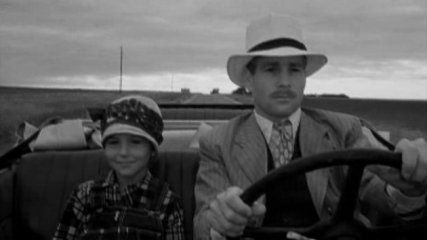Just because a man meets a woman in a barroom don't mean he's your pa.

The roll that Peter Bogdanovich got on starting with 1968's Targets continued with 1973's Paper Moon, his second black-and-white period piece after The Last Picture Show. Set in the Midwest during the Great Depression, it stars Ryan O'Neal as a Bible-peddling con man who's saddled with a nine-year-old girl who may or may not be his daughter (played by Tatum O'Neal, who is his daughter) when he drops by her mother's funeral to pay his respects. His first instinct is to get her out of his hair by putting her on a train, but she has other ideas about that. Furthermore, she proves to be right useful when she inserts herself into his con, which targets the recently widowed.
Something of a chip off the old block (if, in fact, she is a chip off his block), Tatum is so great with figures that she knows exactly how much money they have at any given moment. She also knows exactly what she needs to do when voluptuous dancer Madeline Kahn joins them on the road and is an immediate drain on their bankroll. Together with Kahn's teenage maid (the wonderfully deadpan P.J. Johnson), she hatches a devious scheme that succeeds in getting rid of Kahn, but there's no returning to business as usual for the maybe-father-and-daughter team.
Like What's Up, Doc? before it, Paper Moon was photographed by László Kovács, who manages to make Depression-era Kansas look almost inviting. It was also Bogdanovich's last film to have the benefit of Polly Platt's impeccable production design work since she was no longer his wife by the time it was released. Her touch was definitely missed when he moved on to his adaptation of Henry James's Daisy Miller the following year with his then-muse Cybill Shepherd in the leading role, but that's a story for another night.